- map
- how you can help
- FAQ's
- contact
- copyright
-
ahnentafel and citation # display:| |


| Snapshot: | knight; served in Gascony and Scotland rebelled against King Edward II, and was subsequently imprisoned then became an indentured servant |
| Parents: | 16812996Roger de Shurland His mother's identity is unknown. |
| Born: | by the early 1270's location unknown |
| Died: | circa 1324 location unknown |
| Buried: | in St. Mary and St. Sexburgha Church, Minster on Sea, Isle of Sheppey, Kent, England church's coordinates: N51.4221 E0.8120 |



Who was 16812996Roger de Shurland owned manors at Ufton and Shurland, as proven by a fine dated 5 March 1275.  16812996Roger de Shurland and his (apparently newly aqcuired) manors at Ufton and Shurland are mentioned in this 1275 fine. Full page. 16812996Roger de Shurland is included on the Dering Roll. The relevant portion is copied below, 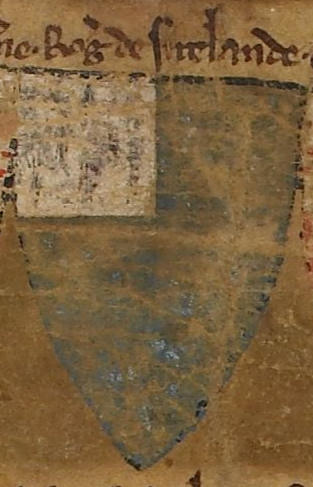 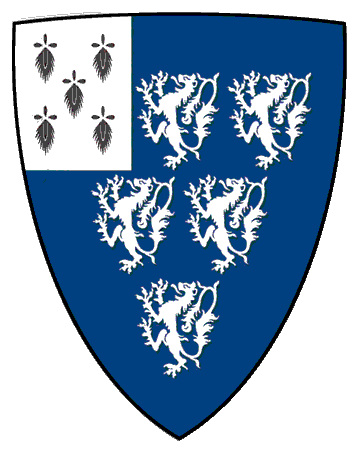 Several decades later, |
On 18 June 1294
After returning to Britain, in 1300
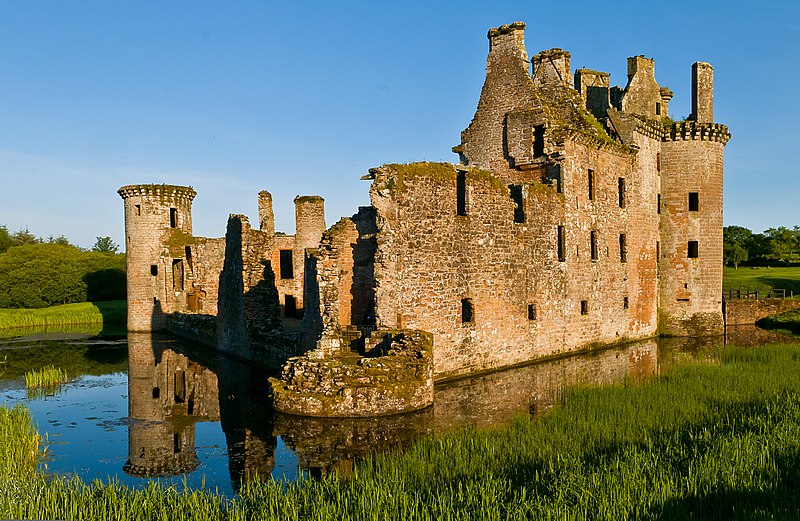
In 1303
In late 1308 or early 1309

In June 1314
The following year he joined yet another expedition against Scotland;
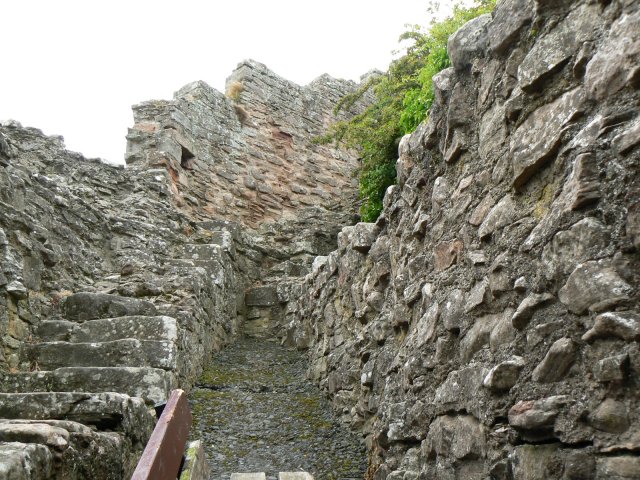
A record dated 8 August 1319 passingly mentions
In 1322
Saul discusses and transcribes (a later copy of) an undated but apparently contemporaneous record that shows that
The last known record to mention
He probably died not long thereafter, yet we don't find the usual estate-related records one might expect. Saul explains:
Normally in the early fourteenth century a knightly landowner’s demise was followed by the temporary seizure of his lands by the escheator and the holding of an inquisition post-mortem. In Shirland’s case, strangely, no such procedure appears to have happened; at least, there is no evidence of it, as there should be, on the Fine Rolls. It is unlikely that Shirland held all of his lands from lords other than the king, which would have rendered such a procedure redundant. It is therefore tempting to wonder whether the younger Despenser took advantage of his retainer’s death to mount a bid to secure possession of his lands. If he did do so, it would have been another action entirely in character with his behaviour.
The tomb shown below lies in St. Mary and St. Sexburgha Church, Minster on Sea, Isle of Sheppey, Kent, which is at coordinates N51.4221 E0.8120.
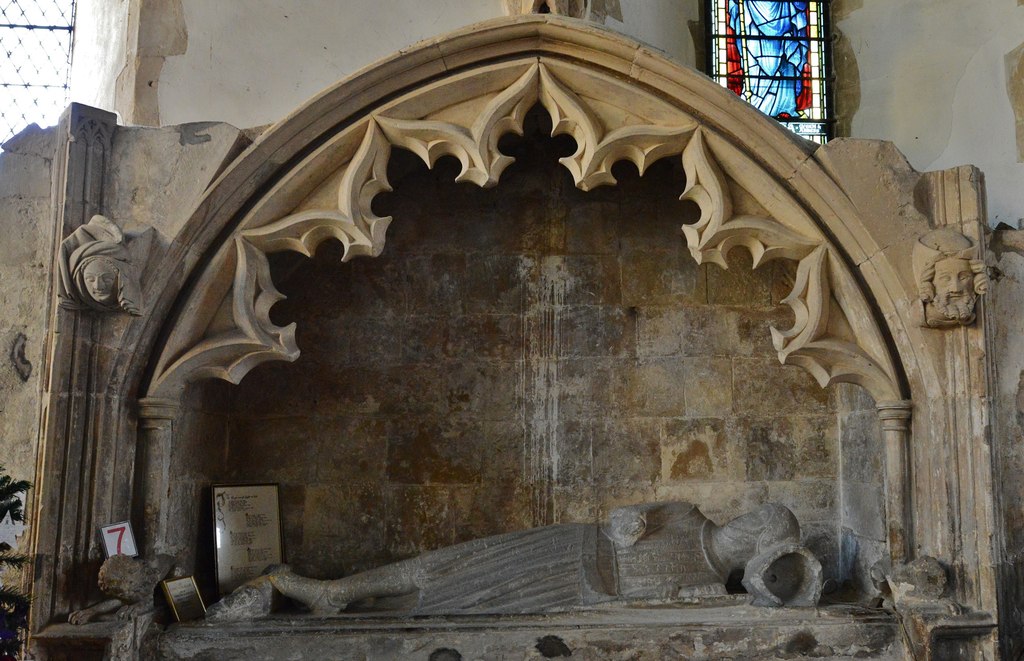

The tomb is generally believed to be
[...] Not uncommonly when knightly lineages died out, the last male representative was honoured by a big, eye-catching monument which kept alive not only his own name but that of the whole family. Such was to be the case with the last of the de Shirlands. [...] Since Robert in his last unhappy years would have been in no position to arrange commemoration on any size or scale, the commissioning of the monument was almost certainly undertaken by his daughter. [...] The entire composition would originally have been adorned with extensive painted decoration, that on the back panel probably depicting a resurrection scene, all of this now lost. Today, there is no obvious means of identifying the knight commemorated; the inscription—assuming there was one—is lost, and so likewise are the shields which would probably have been painted on the front of the chest and perhaps, too, on the architectural surrounds. Weever, writing in the 1630s, was the first to suggest that the person commemorated was none other than Sir Robert de Shirland, observing that the family seat of Shirland lay very close to Minster. C.A. Stothard, in letterpress accompanying his engraving of the monument, published in 1817, noted that the padded surcoat of the effigy had been painted with lions rampant on an azure ground, the arms of de Shirland. The monument can be assigned a date in the 1320s on the evidence of the canopy surrounds, notably the fine ogee cinquefoil cusps, and the presence of a helm as a support under the head. If the person commemorated is actually a de Shirland, as seems certain on the basis of the heraldic evidence, there seems little doubt that that person was Robert and not his father, Roger, who had died before 1290.
What is especially interesting about the tomb, and what makes it relevant to an understanding of Shirland’s career, is its use of imagery relating to the warhorse. In an English context, this is highly exceptional. [...] It is found on only a small minority of examples, all of them early fourteenth century in date; Shirland’s forms one of this group. [...]
[...] His tomb was adorned with the imagery of his most valuable asset, his warhorse. His standing as an elite warrior was being proclaimed. The monument conveys a triumphalist, indeed a highly status-conscious message.
We can be confident that this was a mode of funerary representation of which Shirland would have approved, for it afforded a perfect reflection of his self-image. Although his death had occurred at a time when his personal affairs were in disarray and his family honour besmirched, he was represented on his tomb monument with all the trappings and accoutrements of his knightly profession. In his prime he had excelled, above all, as a fighting knight [...]. He had never been greatly attracted by local politics or administration. [...] Behind the splendour and bombast of Shirland’s own monument, however, lay a story of family crisis. Not only was the hapless Sir Robert the last of his line, a fate which would have distressed the head of any noble lineage in the Middle Ages, but there was also the disaster that in old age he had been broken and humiliated by the younger Despenser. The story of his downfall and bondage is only vaguely hinted at in the terms of his indenture of retainer. Nonetheless, reading between the lines, we need have little doubt that that is the personal tragedy which lies behind it."
A record dated 6 July 1334 (thus about ten years after
The same record also proves that
1: C. A. Stothard, The Monumental Effigies of Great Britain [...] (London, 1817), an insert between pages 38 and 39.
2: Rôles Gascons, Volume III (1290-1307), page 162, entry #2825; page 133, entry #2603.
3: UK National Archives reference CP 25/1/284/20, number 26 [or 27?]. I obtained an image of this record from: Anglo-American Legal Tradition, O'Quinn Law Library, University of Houston; <http://aalt.law.uh.edu/AALT7/CP25(1)/CP25_1_284_20-22/CP25_1_284_20/IMG_0032.htm>, accessed 1 July 2022. You can read an abstract of this record here (It may help to search for the word Schyrlaund.); as you can see, this index states that the record is #26, although the image is clearly labeled #27.
4: Calendar of the Charter Rolls Preserved in the Public Record Office, Volume III: Edward I, Edward II, A.D. 1300-1326 (1908), page 21.
5: Calendar of Inquisitions Post Mortem and Other Analogous Documents Preserved in the Public Record Office, Volume VII, Edward III (London, 1909), page 416.
6: British Library Additional Roll 77720, folio 1r.
7: Wikimedia user Rs-nourse, "The Dering Roll of Arms - Panel 1 - 1 to 54.png" (online image), Wikimedia, <https://commons.wikimedia.org/wiki/File:The_Dering_Roll_of_Arms_-_Panel_1_-_1_to_54.png#file>. The author has shared this image under a Creative Commons BY-SA 3.0 unported license.
8: Collectanea Topographica et Genealogica, Volume 4 (London, 1837), page 69, entry #143. The transcriber apparently is referring back to Cotton MS Otho D IV folio 92.
9: Rôles Gascons, Volume III (1290-1307), page 294, entry #3894; page 319, entry #4104.
10: UK National Archives reference C 47/2/13/8; cited and described in: Nigel Saul, "An Early Private Indenture of Retainer: The Agreement Between Hugh Despenser the Younger and Sir Robert De Shirland," English Historical Review, volume 128, number 532, page 522. Saul's description reads, "In 1300 he served on Edward I’s expedition to besiege Caerlaverock Castle, again in the company of the earl of Lincoln.
11: Thomas Philipott, Villare Cantianum; or, Kent Surveyed and Illustrated, 2
12: Michael Walsh, "Caerlaverock Castle - panoramio (4).jpg" (photo taken 6 June 2014), Wikimedia, <https://commons.wikimedia.org/wiki/File:Caerlaverock_Castle_-_panoramio_(4).jpg>. Mr. Walsh has shared this image under a Creative Commons BY 3.0 license.
13: UK National Archives reference E 101/612/11, membrane 2d; cited and described in: Nigel Saul, "An Early Private Indenture of Retainer: The Agreement Between Hugh Despenser the Younger and Sir Robert De Shirland," English Historical Review, volume 128, number 532, page 522. Saul's description reads, "In 1303 he joined Edward a second time; this time on his march to the far north of Scotland, serving as a knight in the retinue of the prince of Wales."
14: Calendar of Chancery Warrants: A.D. 1244-1326 (London, 1927), page 223.
15: Calendar of Documents Relating to Scotland, Preserved in Her Majesty's Public Record Office, London, Volume 5: 1108-1516 supplementary (1881, London), page 446.
16: F. B. Stitt, "A Dunstable Tournament, 1308-9," The Antiquaries Journal, Volume 32, Issue 3-4 (October 1952), pages 202-203.
17: UK National Archives reference C71/6, membrane 3. Cited in: Nigel Saul, "An Early Private Indenture of Retainer: The Agreement Between Hugh Despenser the Younger and Sir Robert De Shirland," English Historical Review, volume 128, number 532, page 522. Saul's description reads, "After Lincoln’s death in 1311, Shirland performed service principally in the company of the Midlands lord, Sir Richard de Grey of Codnor (Derbyshire). It was under de Grey that he fought at the battle of Bannockburn in June 1314. His role in the desperate encounter is uncertain; he escaped capture, however, [...]."
18: Francis Palgrave, ed., The Parliamentary and Writs and Writs of Military Summons, Volume 2, Division 2, page 428. Described in: Saul, op. cit., page 522.
19: UK National Archives reference C71/7, membrane 3. Cited in: Saul, op. cit., page 522. Saul's description reads, "In 1315 he took part in another expedition against the Scots, this one under the earl of Pembroke, again serving with de Grey."
20: UK National Archives reference E101/15/6, membrane 2. Cited in: Saul, op. cit., page 522. Saul's description reads, "His fine horse, which he had valued, was recorded as worth 50 marks, a figure exceeded in the retinue only by the destrier of de Grey himself."
21: UK National Archives reference C71/10, membranes 5 and 12. Cited in: Saul, op. cit., page 522. Saul's description reads, "He was to serve under de Grey on two further occasions, in 1318 and at the siege of Berwick in 1319."
22: James Allan, "Berwick castle walls," Geograph, <https://www.geograph.org.uk/photo/1379713>. Mr. Allan has shared this image under a Creative Commons BY-SA 2.0 license.
23: Calendar of the Close Rolls Preserved in the Public Record Office, Edward II, Volume VII, 1318-1323 (London, 1895), page 154.
24: Francis Palgrave, Parliamentary Writs and Writs of Military Summons [...], Volume II, Division II (1830), appendix page 201.
25: Calendar of the Close Rolls Preserved in the Public Record Office, Edward II, Volume VII, 1318-1323 (London, 1895), page 627. Described in: Saul, op. cit., page 522. Saul's entry reads, "A couple of months earlier, in February, the constable of the Tower had been ordered to arrange for him to be brought before the king once suitable mainpernors had been arranged."
26: Calendar of the Patent Rolls Preserved in the Public Record Office: Edward II, Volume IV, A.D. 1321–1324 (London, 1904), page 276.
27: British Library, Egerton MS 3789, folio 98v. Transcribed and described in: Saul, op. cit.
28: Calendar of the Patent Rolls Preserved in the Public Record Office: Edward II, Volume IV, A.D. 1321–1324 (London, 1904), page 247.
29: Michael Garlick, "Minster Abbey: The Baron Robert de Shurland (d.1327) monument" (photograph taken 14 December 2016), Geograph, <https://www.geograph.org.uk/photo/5227639>.
30: Michael Garlick, "Minster Abbey: The Baron Robert de Shurland (d.1327) monument with lovely Decorated canopy" (photograph taken 14 December 2016), Geograph, <https://www.geograph.org.uk/photo/5227641>.